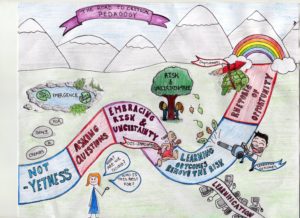For my multimedia reflection assessment I chose to create a sketchnote summarizing the key points from the HybridPod- Questioning Learning podcast by Chris Friend and Amy Collier. I decided to draw the background of my sketchnote by hand. I also printed out some cartoon images (to make up for my lack of artistic skills), which I then glued onto my sketchnote and coloured in. I used my sketchnote to outline the key ideas that I will further describe below.

Amy Collier starts the podcast off talking about the idea of “not-yetness”, an idea that I found very interesting. She talks about how its ok to not know all the answers, and how we should embrace not-knowing and not let it stop us from moving forward. She also talks about how “not-yetness” allows for a space of emergence to be created; where there is understanding and new ideas. Chris and Amy then discuss critical pedagogy and the importance of asking questions, which is the stage that I think I am currently in. In these first few weeks of class we have had a plethora of knowledge thrown at us. This surplus of knowledge has led me to asking a lot of questions on what is important, and what will help me develop my teaching philosophy.
Amy then talks about the idea of learnification, and how technology has really propelled it. I found it interesting that when there is too much learnification, there is actually less learning. Amy gave the example of online classrooms that focus too much on the content and completely forget about the teacher-student relationship. This is an issue that I have had with many online courses throughout my undergrad. There was such a large disconnect between the students and professor, that it took value away from the course. Along with learnification, Chris and Amy discuss the importance of embracing risk and uncertainty. They talk about how learning outcomes can be too restrictive and not allow for enough flexibility; without this flexibility, there is no room for risk and uncertainty. I think risk allows for change, so having that risk and uncertainty is very important for learning to adapt and improve.
Finally, Amy talks about the rhetoric of opportunity, an idea from Mike Caulfield. She mentions how Mike believes that the rhetoric of opportunity is better than the rhetoric of crisis, and how a rhetoric of opportunity allows improvements to move forward and keeps dis-improvements behind. I found this idea interesting, and especially liked Chris’ points about viewing students as people with potential instead of waiting for a student to misbehave. I think that this idea is a really important one, and that the rhetoric of opportunity is an incredibly valuable viewpoint for educators.
[This paragraph has been added after having someone asked me to further explain my design, I also posted this response in one of the comments below:
Finally to talk more about my design, I thought it would be fun to draw out a literal road to critical pedagogy that addressed the key points of the podcast. I started with that first square of not-yetness and the rocks that led to the lake of emergence. I wanted to show how not-yetness created the room for the emergence of new ideas and knowledge. The asking questions square is fairly self-explanatory, but I thought I would draw Amy asking some critical questions). I thought it would be fun to show embracing risk and uncertainty with Amy and Chris literally hugging the risk and uncertain-tree. Along with that, having those risk leafs fall and showing Mr. Learning-Outcome with his leaf-blower blowing away the risk. I used that image to show how rigid learning outcomes remove risk, and are not necessarily good. I drew the diverging path of learnification, to illustrate how in same cases technology can lead to negative learnification, steering us off of the path of critical pedagogy. Finally I ended with the square of the rhetoric of opportunity, with the Improvements Turtle, flying to the “finish line” and the Dis-improvement Rabbit, far behind. I wanted to show how in the road of critical pedagogy the rhetoric of opportunity allows the improvements to surpass the dis-improvements. I put the rainbow at the end, because the end of a rainbow is somewhat mythical, and I think that is the same for the road of critical pedagogy. I don’t think there is a concrete end to the road of critical pedagogy, we can always improve and grow, so the road keeps going. ]
References:
Image Sources:
http://worldartsme.com/images/rainbow-outline-free-clipart-1.jpg
https://img.clipartxtras.com/1825f6b2f97475593f9ffd302d68fca1_lake-clipart-black-and-white-clipartxtras-lake-clipart-black-and-white_1024-768.jpeg
https://st3.depositphotos.com/11514374/18632/v/1600/depositphotos_186329928-stock-illustration-cartoon-of-businesswoman-or-woman.jpg
https://previews.123rf.com/images/alexeyzet/alexeyzet1701/alexeyzet170100007/70672983-lieu-de-bande-dessin%C3%A9e-avec-gar%C3%A7on-et-une-fille-a-touch%C3%A9-l-arbre-sur-le-fond-blanc.jpg
https://thumbs.dreamstime.com/z/funny-cartoon-man-leaf-blower-illustration-68308205.jpg
https://img01.thedrum.com/s3fspublic/drum_kb_article/158038/main_images/TortoiseAndHare_0.jpg
